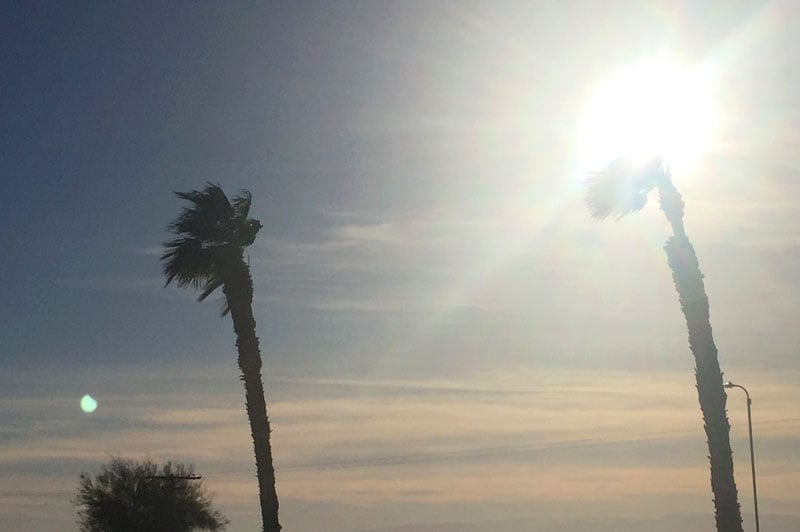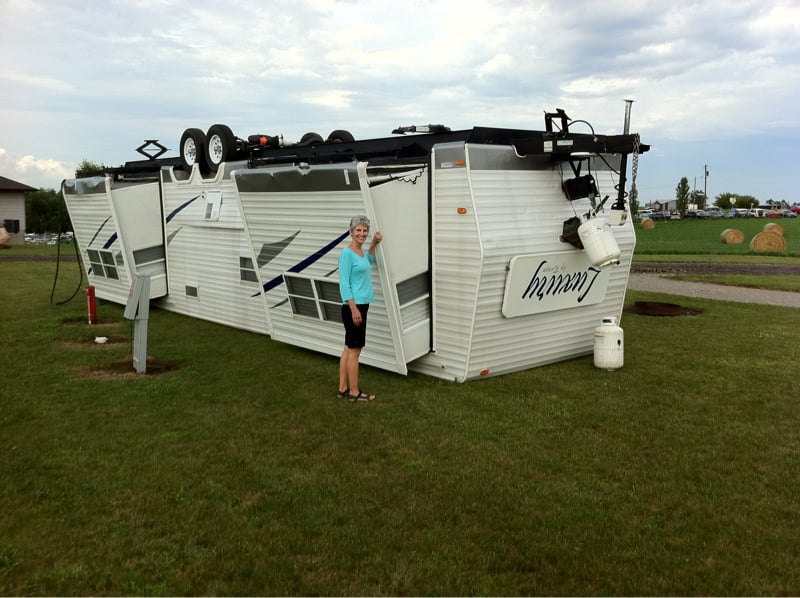The RV lifestyle gets us closer to nature. But sometimes, it gets us a little too close, like when we’re RVing in high winds. If you’re not sure what to do when it happens in a campground, here are three lessons I’ve learned during thirteen years of full-time RVing.
Three Lessons Learned About RVing in High Winds
Out of all the weather that we’ve experienced on the road, RVing in high winds is the most annoying. If you’re new to the lifestyle, it can also be terrifying. I used to think that high winds flip RVs all the time, but based on my experiences, that rarely happens.
It seems like even the biggest, heaviest RVs might blow over during a bad wind storm. Our own Arctic Fox fifth wheel trailer is heavier than most, but in the early days living in ours, I wasn’t sure if we would survive the rocking, rolling and relentless wind pummeling in places like New Mexico and the Southern California desert. Clearly, we did, because I’m here to tell you about it. And this is what I do when we get caught RVing in high winds.
Know the weather forecast.
Keep an eye on weather conditions so you know what to expect in the coming hours. If the forecast calls for winds over 20 miles-per- hour, it’s best to take the following precautions:
Acknowledge that you can’t change the weather.
There’s no doubt about it, bad weather sucks. As my husband says, “wind steals your chi,” and leaves you feeling tired and oftentimes, cold. But complaining about the wind, or any weather, doesn’t change the fact that Mother Nature is having a bad day and you’re part of it. Overcome the mental beating that high winds deliver, then focus on what you can change about your situation.
Park facing into the wind.
If you are able to move before the wind picks up, point the front of the RV into the oncoming wind. This will help avoid getting broadsided by wind, which causes your RV to rock side to side as if you’re on a ship at sea.
Stay hitched up if you’re towing a trailer.
Many times we arrived at a campground knowing that high winds were forecasted. In those cases, it always pays to stay hitched up to to our Dodge RAM 2500. Keeping the fifth wheel in contact with our truck helps the RV feel more stable. Since our Dodge has air bags, releasing a bit of air helps create more stability too.
Retract the awning and put your patio junk away.
This should go without saying, but I can’t tell you how many times we’ve seen flying lawn chairs and broken awnings in high winds.
Keep your stabilizer jacks down.
Stabilizer jacks are a godsend when RVing in high winds. Keep them down to give your RV more contact with the ground.
Retract the slides if the wind is really bad.
If wind is broadsiding your RV and creating lots of bounce, chances are that your slide-outs are making wind effects worse. Retract slides if you can still live inside the rig, then see what happens. As a general rule, I only bring in our slides when wind is hitting us sideways or they’re projected to be over 40 miles per hour for extended periods of time. Our fifth wheel feels much more stable when we do.
These are simple precautions you can take when RVing in high winds. RVing during a tornado warning is an entirely different situation so you need to know what to do there as well if you’re going to survive one.
Windy camping days are never a good time, but thankfully they don’t last forever. For example, on one occasion we endured three days of a bad desert wind storm and thought it would never end. It did, and skies were clear and beautiful when it was over. Like everything in life, there’s a silver lining for even the most annoying or terrifying situations. You’ll likely survive all of them!



WE were in the sand hills out I 20 during a wind storm. It was gusting over 65 MPH and steady at 35 MPH. I added 4 hydralic jacks, one at each corner and pulled in the slides of our 30 foot Motor Home. It still rocked us pretty good. last for 3 days. Part of the time we sat in the front seats belted in. Felt safer that way.
On really high winds do not put jacks down!!
the suspention acts like a fishing pool effect, bends but does not brake.
Good advice, but having been in high winds over the years. I always felt it was better to retract the jacks and have all 6 tires of the motorhome in contact with the ground. This of course meant that we had to bring in the slides, which I believe also helped. A towable may be different.
Do you mean “brake” or “break”??? Correct spelling makes a difference!
Soon good advice here. Because our slides are parallel we would only have access to the master bedroom if both slides were closed. If we are parked and setup for camping with 4 stabilizers down, would we be ok if we closed only the slide facing the wind.
All of the wheels of your RV should always be touching the ground when you have deployed your jacks correctly.
You missed a big one: Fill your water tanks. The tanks are very low and provide a significant ballast to reduce the chances of rollover.
Also if your long term at a given spot consider mobile home tie downs but use heavy cable instead of the straps so you can disconnect them quicker when you do want to move.
We got in an overnight in Rawlins,WY with the wind blowing like crazy. We positioned our T T to head into the wind still attached to the Ford F-350. With luck the wind stopped a little after midnight. I believe stablizers were down. This campground was more of a parking lot, large community room, laundry. Several train loads of coal was being moved during the night.
At what wind speed do you recommend that road travel ends and you pull off the highway?
That is up to the individual driver. I was a commercial truck driver for 15 years and I’ve got some scary high wind stories about RV’s that should have pulled off the road and parked out the wind. As an OTR driver I had the option, if I did not feel it was safe for me to drive my 53′ long 14′ tall trailer in high wind, I could park until it was safe to continue.
I know there are some RVers who wish they had done so.
I travel WY HWY80 frequently and have some similar experiences. Best to check the weather ahead of time and avoid the trip all-together if wind is greater than 30mph. If ice or snow, don’t go! Frequent semi-truck mishaps, they are on the edge of out-of-control, can’t stop on the slick hwy and get blown out of their lane by the wind.
Be sure that the propane tanks are full, it gets cold! There are not many protected RV camp sites, park in between semi’s (wo refrs) in rest stops or behind box stores. I have a small wind turbine intended for sailboats so when the HWY is shut down I can charge the batteries, RV heater will run all night, only difficulty is to keep the turbine upright! Many RV parks will allow you to plugin overnight for under $20.
Our last trip to the Oregon coast in November 2020 we we informed of high winds the next day about 2-3 PM but mother nature had different ideas. That night about 8PM the storm came in and the wind started blowing against the rear of our Lance 880 truck camper about 50-60 MPH then about 11PM the winds picked up and started gusting to about 85-90 MPH. All I can say was were were scared to death and was up all night until the winds quit about 5AM the next morning. Glad all our jacks were down, but the camper rocked side to side from time to time which felt like 2 feet or so. Just plan scary! The wife said no more winter camping for her.
We were driving on I-70 west in the last part of March and the wind was so bad that my husband had the steering wheel of our motorhome turned almost ninety degrees and we were still going forward. It was then that we decided to pull over and wait for the wind to die. It costs us our reservations, but we were glad we did it. It definitely helps to look at the wind forecast.
I would caution about your towable being hitched during high wind. If the RV were to flip there is a chance your tow vehicle could be damaged. Then you are dealing both the damaged RV and your tow vehicle.
One final note on broadside winds. Retracting your slides may create a flatter and broader surface for the winds to push against the side of your rv. I would think keeping them out physically creates a set of angles for the wind and thus the possibility of less straight line wind against the entire surface of your rv.
We are from SW Florida and have ridden out many storms. We always fill our fresh water tank, bring our slides & awnings in.
I sat through a bad storm in my 32′ 6200 lbs TT. The wind was predicted to be about 45, mother nature decided to throw a little extra just before the storm ended the was suddenly the quite and then a very strong wind lifted the trailer and dropped it about 3″ over. with the Newer light weight trailers I would say at 30 mph wind slides in and above if predicted to be 50 or more then your best to stay in a hotel or Motel that night.